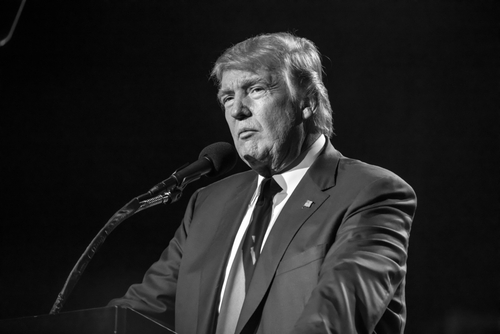Trump at G7: US president calls for end to tariffs and trade barriers
US President Donald Trump says he proposed the elimination of tariffs in talks at the G7 summit in Canada, as the major industrial nations struggled to resolve differences on trade.
Mr Trump said talks with fellow leaders were “extremely productive” despite tensions over his decision to impose tariffs on steel and aluminium imports.
US allies were furious over the move, raising fears of a global trade war.
Mr Trump left early for a landmark meeting with North Korea’s leader.
He is travelling to Singapore to meet with Kim Jong-un on Tuesday to try to persuade him to give up the country’s nuclear weapons.
G7 leaders are yet to comment on Trump’s free trade remarks, but the official Instagram account of German Chancellor Angela Merkel posted a photo of the leaders gathered in what appeared to be a tense meeting.
What did Trump say?
Briefing reporters before he left the town of La Malbaie, in Quebec province, Mr Trump denied that the G7 summit had been contentious.
“No tariffs, no barriers. That’s the way it should be. And no subsidies. I even said, ‘no tariffs’,” the US president said, describing his meetings with fellow Group of Seven leaders as positive “on the need to have fair and reciprocal trade”.
“The United States has been taken advantage of for decades and decades,” he continued, describing America as a “piggy bank that everyone keeps robbing”.
But he said he did not blame G7 leaders for the “unfair” trade deals – instead blaming his American predecessors.
Angered by the high steel and aluminium tariffs, Canada, Mexico and the EU have all said they are all planning retaliatory measures.
President Trump warned against such moves, calling it a “mistake” and said if it gets as far as a trade war, then the US would “win that war a thousand times out of a thousand”.
With divisions over trade laid bare, it still unclear whether a communique agreed by each G7 member will be released when the summit concludes later on Saturday.
‘Sticking points remain’
Jessica Murphy, BBC News, Quebec
The US president has made it clear he believes the removal of tariffs against his G7 allies should come at a price – and he doesn’t expect the US to pick up the tab.
His statements on the sidelines of the contentious G7 summit come just weeks after his administration slapped metals tariffs on Canada, the US and Mexico, who quickly announced their own retaliatory measures.
Sticking points also remain in the North American Free Trade Agreement (Nafta) renegotiations between Canada, the US and Mexico, despite it being a key topic during the bilateral meeting between Mr Trump and Canadian PM Justin Trudeau.
The American leader said a three-country deal would only be possible with substantial changes, and reiterated his interest instead in forming separate two-way trade accords with Mexico and Canada – an interest Canada has made clear it does not share.
While the consensus-based G7 might well agree on the benefits of both free and fair trade between economic allies, it appears what that could look like it still up for debate.
Why are there divisions?
On 1 June, the US imposed a 25% tariff for steel and 10% for aluminium on imports from the EU, Canada, and Mexico. Mr Trump said the move would protect domestic producers that were vital to US security.
The EU then announced tariffs on US goods ranging from Harley-Davidson motorcycles to bourbon. Canada and Mexico are also planning retaliatory moves.
On Friday Canada’s foreign minister called the tariffs “illegal “. European Council President Donald Tusk said they threatened the “rules-based international order”.
UK Prime Minister Theresa May has said she wants the EU to act with restraint.
French President Emmanuel Macron said he believed all sides were willing to reach agreement.
What is the G7?
It is an annual summit bringing together Canada, the US, the UK, France, Italy, Japan and Germany, which represent more than 60% of global net worth between them.
Economics tops the agenda, although the meetings now always branch off to cover major global issues.
Russia was suspended from the group in 2014 because of its annexation of Crimea from Ukraine. On Friday, Mr Trump made a surprise call for Moscow to be readmitted, but German Chancellor Angela Merkel said other members were against the idea.
Meanwhile, another international summit is being held in China. President Xi Jinping is hosting a meeting of the Shanghai Co-operation Organisation (SCO), a regional security bloc, in the eastern city of Qingdao.
President Vladimir Putin of Russia, as well as leaders from Iran, India, Pakistan, and four central Asian leaders, are taking part.
What else is being discussed at the G7?
The five themes for this year’s summit are:
- Inclusive economic growth
- Gender equality and women’s empowerment
- World security
- Jobs of the future
- Climate change and oceans
Mr Trump was thought likely to miss the talks on climate change, the environment and probably gender equality on Saturday.
The US president was the odd man out on climate change during the G7 in Italy last year, later announcing his intention to withdraw from the landmark Paris agreement.
Iran is also a sticking point. Mr Trump recently ditched the 2015 agreement aimed at curbing Iran’s nuclear programme. This angered the other signatories who have since sought to shore it up.

